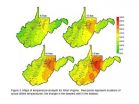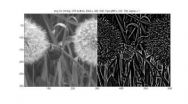(Press-News.org) OAK RIDGE, Tenn., Oct. 5, 2010 -- By installing wireless sensors and replacing faulty traps along the 12 miles of steam lines at Oak Ridge National Laboratory, officials expect to save as much as $675,000 per year.
With 1,600 steam traps, which normally open slightly to discharge condensed steam with a negligible loss of live steam, the problem occurs when a trap fails and that failure goes undetected and unrepaired, said Teja Kuruganti, a member of the Computational Sciences and Engineering Division.
Manual inspections of each trap is a daunting and sometimes dangerous task, but by collecting and monitoring data initially from 30 sensors at five steam trap locations, the team of researchers expects to demonstrate significant savings.
Steam is used at ORNL, industrial sites and universities throughout the nation for heating and cooling buildings. A Department of Energy study published in 2005, however, identified faulty steam traps as a major source of energy waste at industrial sites. "Approximately 20 percent of the steam leaving a central boiler plant is lost via leaking traps in typical space heating systems without proactive assessment programs," the report, "Steam Trap Performance Assessment," stated.
With this project, ORNL researchers see a chance to save money, reduce the lab's carbon footprint and lead by example.
Working with Johnson Controls, ORNL has already repaired or replaced any faulty traps, and is considering expanding the wireless sensor system by installing hundreds of sensors.
"The installation of wireless sensors throughout much of the steam system can give us an early warning of component failures or impending failures," said Wayne Parker of ORNL's Utilities Division. "Catching problems as early as possible is essential in minimizing losses and maximizing savings."
Kuruganti noted that wireless capability is "an ORNL hallmark" and this project leverages tools and technologies developed under the DOE Industrial Wireless Program. The sensors will monitor steam flow and temperature. The project will use the ORNL-developed Sensorpedia technology for standards-based information visualization.
INFORMATION:
Others involved in this project are Glenn Allgood, Joe Lake, Seddik Djouadi, Wayne Manges, Robert Baugh, Teresa Baer, Rob Crowell, Kenneth Woodworth, Mohammed Olama and Rangan Sukumar.
ORNL is managed by UT-Battelle for the Department of Energy's Office of Science.
NOTE TO EDITORS: You may read other press releases from Oak Ridge National Laboratory or learn more about the lab at http://www.ornl.gov/news. Additional information about ORNL is available at the sites below:
Twitter - http://twitter.com/oakridgelabnews
RSS Feeds - http://www.ornl.gov/ornlhome/rss_feeds.shtml
Flickr - http://www.flickr.com/photos/oakridgelab
YouTube - http://www.youtube.com/user/OakRidgeNationalLab
LinkedIn - http://www.linkedin.com/companies/oak-ridge-national-laboratory
Facebook - http://www.facebook.com/Oak.Ridge.National.Laboratory
Image: http://www.ornl.gov/info/press_releases/photos/steam%201.JPG
Cutline: Twelve miles of steam lines at Oak Ridge National Laboratory provide lots of opportunities for steam to escape. (Photo by Ron Walli/ORNL)
ORNL uses new technologies to take steam out of wasted energy
2010-10-06
ELSE PRESS RELEASES FROM THIS DATE:
SMU geothermal mapping project reveals large, green energy source in coal country
2010-10-06
DALLAS (SMU) – New research produced by Southern Methodist University's Geothermal Laboratory, funded by a grant from Google.org, suggests that the temperature of the Earth beneath the state of West Virginia is significantly higher than previously estimated and capable of supporting commercial baseload geothermal energy production.
Geothermal energy is the use of the Earth's heat to produce heat and electricity. "Geothermal is an extremely reliable form of energy, and it generates power 24/7, which makes it a baseload source like coal or nuclear," said David Blackwell, ...
Sediment pollution should be included in water quality assessment
2010-10-06
Under the Water Framework Directive (WFD) (Directive 2000/60/CE), member states are required to achieve Good Water Status for water (continental, estuarine, subterranean and coastal water bodies) in Europe by 2015. Surface water quality is assessed taking into account the ecological and chemical status.
The quality of aquatic systems is more accurately assessed using the status of both the water column and the underlying sediment. A recent study by researchers of AZTI-Tecnalia concluded that water bodies risk being misclassified if, on evaluating their chemical status, ...
New graphene fabrication method uses silicon carbide templates to create desired growth
2010-10-06
Researchers at the Georgia Institute of Technology have developed a new "templated growth" technique for fabricating nanometer-scale graphene devices. The method addresses what had been a significant obstacle to the use of this promising material in future generations of high-performance electronic devices.
The technique involves etching patterns into the silicon carbide surfaces on which epitaxial graphene is grown. The patterns serve as templates directing the growth of graphene structures, allowing the formation of nanoribbons of specific widths without the use of ...
New findings about wind farms could lead to expanding their use
2010-10-06
CHAMPAIGN, Ill. — Wind power is likely to play a large role in the future of sustainable, clean energy, but wide-scale adoption has remained elusive. Now, researchers have found wind farms' effects on local temperatures and proposed strategies for mediating those effects, increasing the potential to expand wind farms to a utility-scale energy resource.
Led by University of Illinois professor of atmospheric sciences Somnath Baidya Roy, the research team will publish its findings in the Proceedings of the National Academy of Sciences. The paper will appear in the journal's ...
The world is full of darkness, reflected in the physiology of the human retina, Penn researchers say
2010-10-06
PHILADELPHIA –- Physicists and neuroscientists from the University of Pennsylvania have linked the cell structure of the retina to the light and dark contrasts of the natural world, demonstrating the likelihood that the neural pathways humans use for seeing are adapted to best capture the world around us.
Researchers found that retinal ganglion cells that see darkness are more numerous and cluster closer together than those that see light, corresponding to the fact that the natural world contains more dark spots than light. Now physicists, and not just pessimists, ...
Georgia Tech researchers design system to trace call paths across multiple networks
2010-10-06
Phishing scams are making the leap from email to the world's voice systems, and a team of researchers in the Georgia Tech College of Computing has found a way to tag fraudulent calls with a digital "fingerprint" that will help separate legitimate calls from phone scams.
Voice phishing (or "vishing") has become much more prevalent with the advent of cellular and voice IP (VoIP) networks, which enable criminals both to route calls through multiple networks to avoid detection and to fake caller ID information. However each network through which a call is routed leaves its ...
Researcher finds top reasons for Facebook unfriending
2010-10-06
DENVER (October 5, 2010) - With over 500 million users worldwide, Facebook has become a global phenomenon, a vast cyber neighborhood where friends meet to share photos, news and gossip.
But when those relationships sour, another phenomenon often occurs – unfriending.
In what may be the first comprehensive study of its kind, a University of Colorado Denver Business School student has revealed the top reasons for Facebook unfriending, who is unfriended and how they react to being unfriended.
"Researchers spend a lot of time examining how people form friendships online ...
A tracking device that fits on the head of a pin
2010-10-06
Optical gyroscopes, also known as rotation sensors, are widely used as a navigational tool in vehicles from ships to airplanes, measuring the rotation rates of a vehicle on three axes to evaluate its exact position and orientation. Prof. Koby Scheuer of Tel Aviv University's School of Physical Engineering is now scaling down this crucial sensing technology for use in smartphones, medical equipment and more futuristic technologies.
Working in collaboration with Israel's Department of Defense, Prof. Scheuer and his team of researchers have developed nano-sized optical gyroscopes ...
Better cholesterol drugs may follow Saint Louis University researcher's breakthrough
2010-10-06
ST. LOUIS – Thanks to a discovery by a Saint Louis University researcher, scientists have identified an important microRNA that may allow us to better control cholesterol levels in blood.
Led by Ángel Baldán, Ph.D., assistant professor of biochemistry and molecular biology at Saint Louis University and published in a recent issue of Proceedings of the National Academy of Sciences of the United States of America, the study found that the microRNA miR-33, may be key to controlling HDL, or "good" cholesterol levels.
In the U.S., heart attack, stroke, and peripheral ...
October 2010 issue of the Bulletin of the Seismological Society of America
2010-10-06
Causal relationship between rainfall and earthquakes detailed
This review article explores natural crustal earthquakes associated with the elements of the hydrologic cycle, which describes the continuous movement of water on, above and below the surface of the Earth, including hurricanes and typhoons. The theory of hydroseismicity, first articulated in 1987, attributes most intraplate and near-intraplate earthquakes, to the dynamics of the hydrological cycle.
The Hydroseismicity hypothesis suggests variations in rainfall affect pore-fluid pressure at depth and can ...

